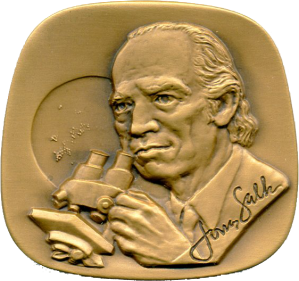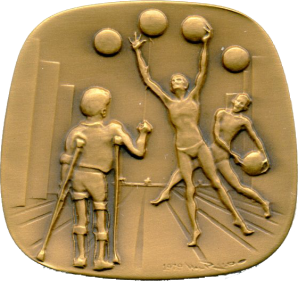 |  |
Jonas Salk medal designed by Hal Reed, struck by Metal Arts in quantities of 300 bronze, 30 pewter,
110 pure silver & 35 10kt gold. Obverse: Portrait, Jonas Salk (signature. Reverse: Polio victim on
crutches watches two boys playing with balls; Salk Institute in background; 1979 Hal Reed. 47 x 45 mm.
Jonas Edward Salk was born in New York City on October 28, 1914. After graduating from the City College of New York, he went on to be a research fellow at the University of Michigan. There he helped in the development of an influenza vaccine and served as a member of the U.S. Army Influenza Commission. Moving to the University of Pittsburgh’s School of Medicine, Salk became Research Professor of Bacteriology in 1949, Professor of Preventive Medicine 5 years later, and finally Professor of Experimental Medicine (1957-1963).
At the University of Pittsburgh, Salk did research into poliomyelitis, developing immunological methods to distinguish different types of the virus. He then developed a vaccine prepared by inactivating the virus. Massive field trials conducted by the National Foundation for Infantile Paralysis in 1954, confirmed the effectiveness of the vaccine, which became the first weapon against the polio scourge. In the years immediately before mass inoculations with the Salk vaccine began, there was an average of 25,000 cases a year in the United States. In 1969 not a single death from polio was reported in the nation, and the disease has virtually been eradicated worldwide. For his pioneering accomplishment, Dr. Salk received many honors and awards, including the Presidential Citation and the Congressional Medal for Distinguished Achievement.
Salk served as an expert on virus diseases for the World Health Organization in 1961, and two years later founded the Salk Institute for Biological Studies at La Jolla, California, which he directed until his death. The Salk Institute is one of the world’s major independent centers of biological research, with an annual budget of over 12 million dollars and a staff of over 400. It is an architectural masterpiece by Louis Kahn. One of the great strengths of this “Athens of the Pacific” is the enhanced insight that arises from the interdisciplinary approach to problems and from the exchange of ideas of scientists from all over the world.